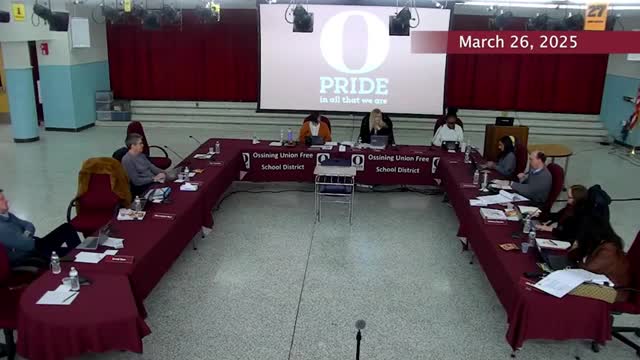School Board evaluates 1.67 tax levy amidst ongoing budget discussions
March 29, 2025 | OSSINING UNION FREE SCHOOL DISTRICT, School Districts, New York
This article was created by AI summarizing key points discussed. AI makes mistakes, so for full details and context, please refer to the video of the full meeting. Please report any errors so we can fix them. Report an error »

In a recent Board of Education meeting held on March 26, 2025, in New York, board members engaged in a thorough discussion regarding the upcoming budget, focusing on the proposed tax levy of 1.67%. The atmosphere was charged with anticipation as trustees sought to gauge consensus on the budgetary direction for the upcoming year.
As the meeting unfolded, board members expressed their eagerness to evaluate the effectiveness of their current strategies in two months. One trustee suggested that the administration should collaborate with educational leaders to ensure that all districts are aligned and supported in their efforts. This collaborative spirit was evident as they discussed the implementation of a new forecasting tool, Forecast 5, which was recommended by various districts to enhance their budgeting processes.
The conversation quickly shifted to the budget itself, with trustees weighing the implications of the proposed tax levy. While most members signaled their support for the 1.67% figure, there were lingering questions about potential adjustments and efficiencies within the budget. One trustee emphasized the importance of maintaining flexibility in the budget to accommodate unforeseen changes, highlighting the challenges that could arise in the following year.
The board acknowledged the constraints of the tax cap, which limits their ability to increase the levy without an override. This reality prompted discussions about the necessity of making strategic cuts if additional funding was required for new programs or positions. The administration presented a list of potential staffing needs, categorized into "must-haves," "important," and "nice-to-haves," illustrating the difficult choices they face in balancing educational needs with fiscal responsibility.
As the meeting progressed, the urgency of finalizing the budget became apparent. Board members recognized that decisions made now would have lasting impacts on future funding and flexibility. The administration reassured the board that they had conducted a thorough review of the budget, ensuring that it reflected the community's priorities while remaining under the 2% increase threshold.
In closing, the board expressed a commitment to transparency and collaboration, encouraging members to review data from other districts to inform their decisions. With the deadline for budget proposals looming, the board appeared poised to finalize their plans, setting the stage for the educational landscape in the coming year.
As the meeting unfolded, board members expressed their eagerness to evaluate the effectiveness of their current strategies in two months. One trustee suggested that the administration should collaborate with educational leaders to ensure that all districts are aligned and supported in their efforts. This collaborative spirit was evident as they discussed the implementation of a new forecasting tool, Forecast 5, which was recommended by various districts to enhance their budgeting processes.
The conversation quickly shifted to the budget itself, with trustees weighing the implications of the proposed tax levy. While most members signaled their support for the 1.67% figure, there were lingering questions about potential adjustments and efficiencies within the budget. One trustee emphasized the importance of maintaining flexibility in the budget to accommodate unforeseen changes, highlighting the challenges that could arise in the following year.
The board acknowledged the constraints of the tax cap, which limits their ability to increase the levy without an override. This reality prompted discussions about the necessity of making strategic cuts if additional funding was required for new programs or positions. The administration presented a list of potential staffing needs, categorized into "must-haves," "important," and "nice-to-haves," illustrating the difficult choices they face in balancing educational needs with fiscal responsibility.
As the meeting progressed, the urgency of finalizing the budget became apparent. Board members recognized that decisions made now would have lasting impacts on future funding and flexibility. The administration reassured the board that they had conducted a thorough review of the budget, ensuring that it reflected the community's priorities while remaining under the 2% increase threshold.
In closing, the board expressed a commitment to transparency and collaboration, encouraging members to review data from other districts to inform their decisions. With the deadline for budget proposals looming, the board appeared poised to finalize their plans, setting the stage for the educational landscape in the coming year.
View full meeting
This article is based on a recent meeting—watch the full video and explore the complete transcript for deeper insights into the discussion.
View full meeting
